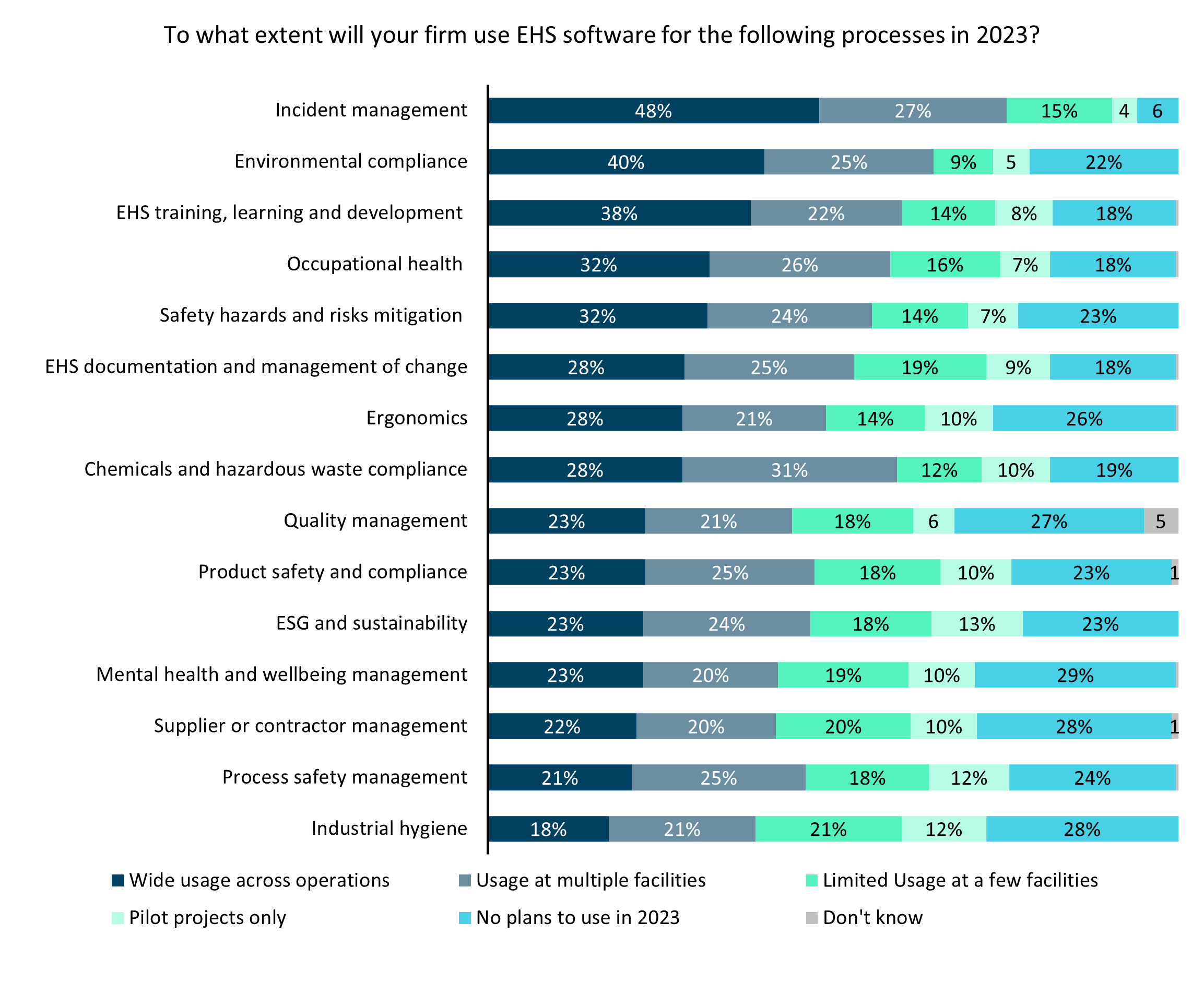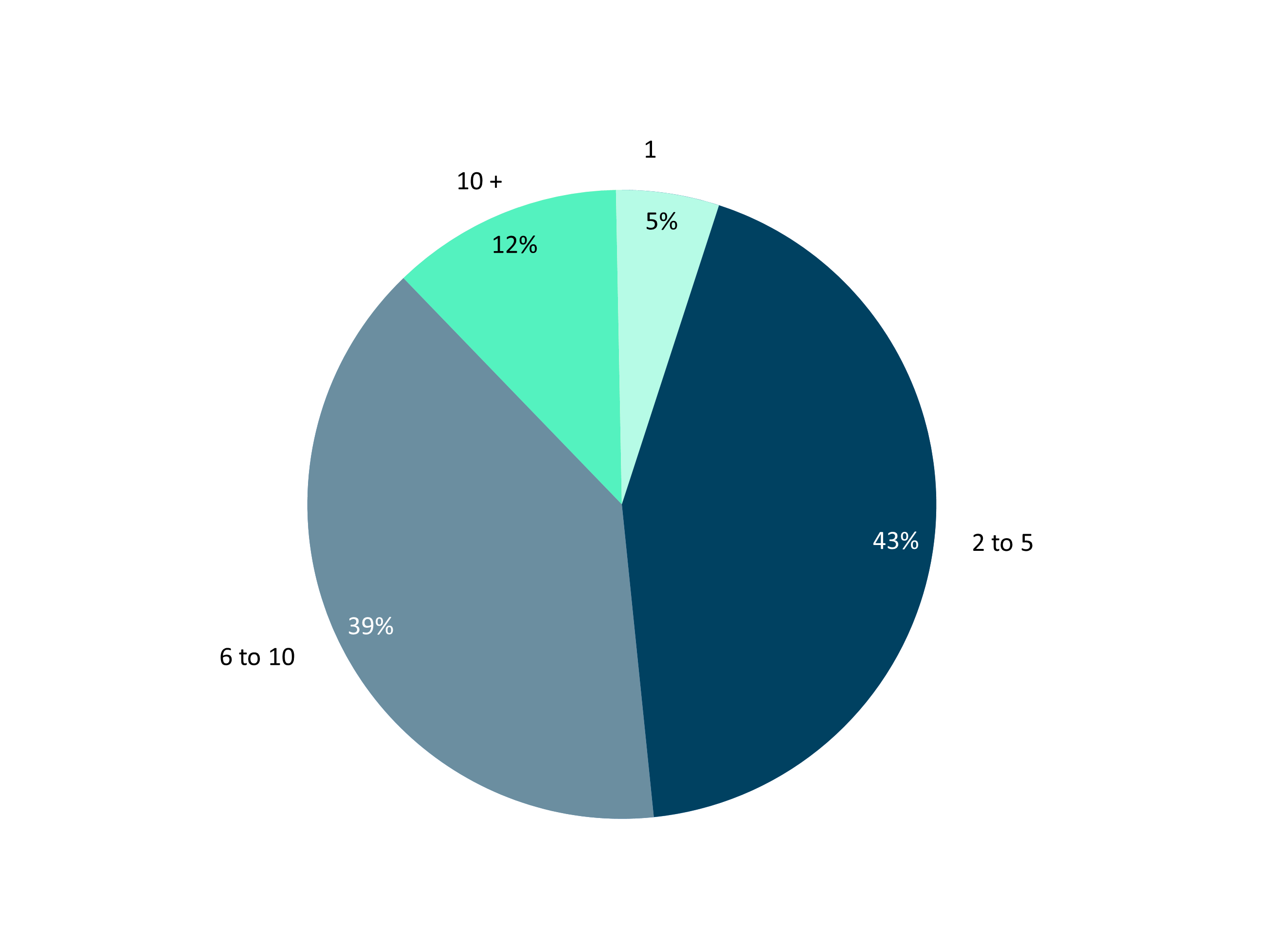Dealing with the Challenges of Scaling an EHSQ System Across Your Organization
Scaling software across your organization can seem like an intimidating process. So, before you get started, it’s important to plan ahead and be prepared for what that might look like. Make sure that you structure it in a way that you’re not overwhelmed by the scope of the project. This article will help prepare you by reviewing the risks and challenges of scaling and how to overcome them.
Data From Independent Analyst Verdantix Shows Inefficient Operations for EHS Systems
In a recent global survey of over 300 EHS leaders, Verdantix gathered some interesting insights on the way companies are currently using EHSQ software.
The first chart shown below captures the lag between corporate ambitions to really digitize all these EHS processes and actually getting the software into the hands of their employees. What this survey really highlights is that apart from the core modules, more often than not, it’s the case that firms have struggled, stalled, or outright failed to digitize EHS processes across the entire business.

One of the main reasons behind this implementation gap is that EHS software rollouts are arduous tasks. And many firms find themselves perpetually in the process of completing global rollouts, which is a very difficult journey for everyone involved.
In the same study, Verdantix identified that many firms rely on a number of EHS solutions across the business to manage their overall EHS programs.
As you can see from the pie chart below, over half of the respondents in the survey are using six or more solutions for their EHSQ systems. Companies will pick and choose software modules from various vendors based on their functional merits and they’ll integrate them all together into a huge project. This can be a big undertaking and often creates inefficiencies for the business.

Source: Verdantix Global Corporate Survey 2022: EHS Budgets, Priorities & Tech Preferences
Using multiple systems is really a symptom of these organizations really struggling to scale EHS software across their business. Instead, they rely on legacy systems based in small jurisdictions, or they hastily implement single modules as a real stop gap during a wider scale implementation process. And these individual systems often exist in silos. They’ve got different workflows, they’ve got a different look and feel, and they produce inconsistent outputs.
Firms who rely on this unconsolidated array of different EHS software systems miss out on a whole host of potential benefits from an effective solution.
Some of the benefits of having a consolidated EHSQ system include:
- Centralized EHSQ data
- Improved data analysis
- Avoiding duplicated work efforts
- More appealing to IT functions
- Workflow consistency
- Lower subscription costs
In order to take advantage of these benefits, organizations should consider using an all-in-one EHSQ software solution that can be scaled across the entire organization.
Key Factors for Scaling an EHSQ System Across the Organization
To be successful, there are some key factors and considerations that you should keep in mind before you begin scaling at a wider level. This will help enhance and align your software alongside the business.
The first important consideration is to find the right balance between flexibility and standardization of the EHSQ system, especially within your forms and workflows.
Flexibility is centered around letting those separate entities, departments, and personnel within your business fulfill their EHS needs effectively. But then you also must consider standardization and the benefits of being able to quickly and effectively fulfill global EHS reporting requirements in a consistent manner.
You must find a solution that gives you the configurability to find the right balance between being flexible and standardized.
Another important insight to emphasize is that ease of use is paramount. Be sure to invest heavily in making the software more usable for your employees.
Make sure throughout the rollout, you go out to people and get the software in their hands, get their feedback, and make sure you have their language needs, their cultural requirements, etc. in place to help make the software system work effectively for them.
Case Study on What Happens When Scaling Goes Wrong
Verdantix provides us with a prime example of a large company that had diverted a lot of resources into EHS software development but unfortunately, their scaling process was disjointed. They made a lot of poor decisions without the proper foresight and consideration of the overall bigger picture.
In this case, stakeholders were taking modules for themselves and pulling them in different directions, doing their own thing with customizations and configurations of different modules. This led to a lot of poor technical decisions and a lot of over-customization that really compromised the integrity of the system itself. This led to inconsistent outputs, a lack of integration opportunities, and a lot of inconsistency throughout workflows and data.
The mistakes that were made had real damning effects on the performance of the software. Some of which include:
- The confused processes and lack of uniformity made it difficult for a lot of the users who just stopped using the system after really struggling with it.
- The lack of data being entered, or data being entered wrong, makeing it challenging to collect and aggregate data for the EHS managers on the backend.
- The over-customization and compromising of the system itself led to loads of technical errors and work orders for the IT department.
So by not having a look at the bigger picture or having a clear idea of what the system was meant to achieve, the firm was very disjointed in the scaling process. It left data and modules siloed. User engagement went way down. And they didn’t even integrate with an active directory because they’d over-customized and compromised the system.
The unfortunate aspect in a lot of these cases of inefficient scaling is that the firm just loses faith in the system completely and decides to ditch it, or maybe get a new EHS software system, or even go back to manual spreadsheets. And with so much time, effort, and money invested, it’s such a costly lesson for companies to learn.
The best summary to take away from this is that in order to really reap the benefits of scaling EHS software, you must give it the attention it deserves with careful planning and preparation.
Critical Success Factors When Scaling Globally
One of the biggest success factors is the involvement of your project teams. The leadership and accountability of your team members will make a significant difference in the effectiveness of your scaling and implementation efforts.
Another aspect is managing the rollout to other units geographically with other teams. Having a good rollout plan and being able to drive this rollout through the organization is critical. One way to help ensure this happens is to work with the vendor to determine a priority of which modules will be implemented – when and where appropriate to help meet your goals. You should always involve the local site of course and have a team there with whom you can work.
Planning to Scale Your EHS System
When it comes to the planning and kickstarting phase of a scaling project, it’s important to always consider any digital transformation as a journey. And to be able to reach a certain destination early in the project to gain some traction and engagement from people.
You may want to start with a phased approach. For example, phase zero would be identifying a process that will bring a lot of value early on in the journey. This helps motivate people and when they see that it has a positive impact early on, it triggers more engagement from everyone. You also want to have results as soon as possible and this can help.
Starting small allows the vendor to deliver faster on those results, but also to gain progressive insight as you go along. This is very important as often you may have an idea of the implementation process, but as you go through it, you will learn new things. And you want to have the ability to pivot rapidly to be able to include those insights as soon as possible in the process.
Another crucial aspect is training. Very often training is considered as a last step, but it’s important to have training as soon as possible. This helps you fully leverage the capabilities of the platform early on.
You want to provide training to key stakeholders, key users, and project teams. Comprehensive training brings less frustration and helps avoid stop gaps.
Measuring a Successful Scaling Effort
Once you’ve done your planning and scaling efforts, you can measure your success in a few different ways. One of which is identifying the number of items created. The more data, input, and action items, the more usage you and your team are getting out of the software.
From a global perspective, you can see that it’s growing geographically or in the number of users with better-aggregated reporting. Your software should allow you to pull reports across different units or sites.
Being able to do that aggregation should show you that you’re scaling and to see the implementation continuously growing, adding more modules, processes, users, or units means you are on the right track for effective scaling.
How TenForce helps its customers scale
With TenForce, users have access to all the benefits of an all-in-one platform. It allows our users to easily adopt multiple modules. We typically recommend our customers start with a small implementation of one to three modules for two to three sites. That gives you enough focus to not get distracted and also guarantees a broader view of the needs of the company. This will help ensure a successful rollout and will prepare you to scale after that initial implementation.
Watch the complete Scaling an EHS System Across the Organization webinar here.
